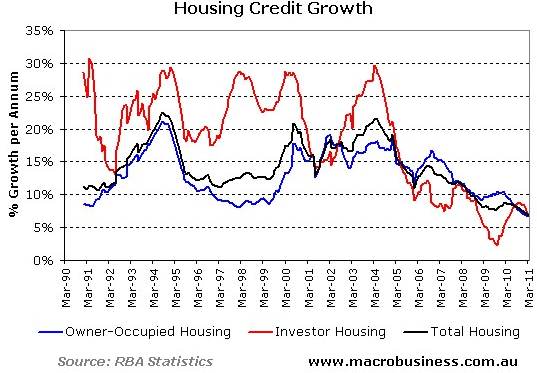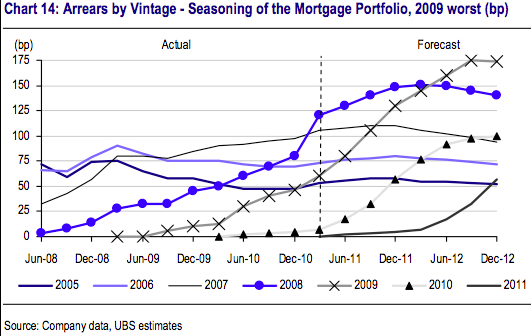Over the last few months at Macrobusiness we have been discussing the changing face of the economy in light of what seems to be a guided transition away from the “old growth” economy which was driven mainly by credit tipped into housing. This presents an issue for the vendors of the old economy, especially the banks. You can see from the chart below that the issuance of housing credit is now growing at its lowest rate in decades with a strong downward trend.
As I have talked about previously, the lowering of the rate of credit issuance leads to falling growth in house prices. This creates a negative feedback loop that drives down demand for housing until a point is reached when the lower prices again trigger some further demand. The issue for banks is that while credit issuances rates fall so does their potential for profits. Due to this fall in loan turn-over we have seen the Australian banks start to use some more “creative” ways to keep their underlying profits intact. In the first two reporting quarters of this financial year you may have noticed many media reports that looked something like this:
Westpac’s third-quarter cash profit rose 27 per cent to $1.4 billion, helped by a sharp fall away in the level of bad debts, but the total fell shy of analysts’ targets.
And:
Commonwealth Bank of Australia (CBA), Australia’s biggest lender by market capitalisation, reported a record first half cash profit of $3.34 billion, up 13% from the prior corresponding period. Net profit for the six months to December rose to $3.05 billion from $2.91 billion the previous year.
CBA’s first half profit rise was mainly a result of continuing falls in bad debt provisions, down 48% from $1.38 billion in the previous period to $722 million in the six months to December.
And:
ANZ kicked off the big banks’ interim reporting season by posting an net profit of $2.66 billion, 38 per cent better than a year earlier, fueled by lower bad debt provisions and solid growth across its businesses.
And:
National Australia Bank Ltd has beat market expectations to reveal an 18 per cent lift in first-quarter cash profit thanks to lower provisions for bad debts and increased banking revenue.
You may have noticed that all of those story clips have something in common. That commonality was also noted by the ABC back in early May.
Another half-year gone, fresh record profits posted by three of the four major banks, situation normal, right?
Wrong.
It’s true that profits for all the major banks, except NAB, are well and truly back above pre-financial crisis levels.
But it tells you something about how those results were achieved that it was the straggler, NAB, which most impressed analysts and the share market with its non-record profit.
Analysis by two of Australia’s major accounting firms, KPMG and PwC, shows that nearly half of the major banks’ profit increase has come from a reduction in bad and doubtful debt provisions – that is the money they set aside to cover losses from loans they think won’t be repaid in full.
As we have seen lately that decision to lower bad debt provisioning in order to satisfy equity holders may have been a costly one. As reported by H&H , a recent UBS report states:
We believe that it is highly likely that the large 2009 Vintage may prove to be the worst quality cohort across the bank’s portfolio. Many borrowers in 2009 were enticed into the market through the Government’s First Home Owner’s Grant and other stimulatory policies, as well as the sharp reduction in interest rates. This enabled many borrowers who would otherwise have not been able to enter the market to take out a mortgage. Chart 13 illustrates the Bank’s Discounted Mortgage Rate (the Standard Variable Rate less a discount which is available to most borrowers). The discounted mortgage rate peaked at just below 9% in August 2008, immediately prior to the rapid rate-cutting cycle by the RBA. By April 2009 the Discounted Mortgage Rate had fallen by 3.85% to just 5.10%. This was the lowest mortgage rate in Australia since 1964.
Although as part of their loan approval process the banks add on an interest rate buffer (the banks stated that this was around 2% at the time) the rapid rise in mortgage rates as Australia recovered from the financial crisis is likely to have caught many 2009 Vintage borrowers by surprise. Combined with pressure on household budgets from higher utility bills, food and petrol prices we believe that many 2009 Vintage borrowers are likely to go into arrears as this pool seasons. These factors are likely to place more pressure on borrowers from the 2009 Vintage than the 2008 Vintage purely as mortgage rates were on average materially lower when they drew down there loans. For the majority of the 2008 Vintage (those who borrowed prior to August 2008) rates are likely to still be lower than when they took out their mortgage. Thus, we believe that it is logical and highly likely that the 2009 Vintage will turn out to have the highest level of mortgage delinquencies.
So the banks may now be in a bind. They have previously lowered their provision for bad debts at a time when new lending is falling and are now facing a headwind that may require them to re-ramp up those provisions. This scenario will obviously be negative for bank profits. It therefore comes as little surprise to note that Gail Kelly from Westpac is being very public at talking down the risks.
Westpac chief executive Gail Kelly has gone out of her way to reassure the market the recent rise in mortgage arrears is not out of the ordinary and the bank is not concerned that more people are unable to make their repayments.
However, while property experts say they are not concerned with the current rate of arrears, they say they could keep rising if interest rates are increased and wages remain flat.
The comments come just days after Fitch released a report showing delinquencies are at a record high and could increase further.
Speaking with the Australian Financial Review, Kelly said although mortgage arrears have increased the fundamentals of the economy will keep the housing market intact.
“It’s really a softening rather than any underlying concerns so I remain very confident about the Australian housing situation…I think delinquencies will pick up but they are off a low base.”
Kelly also said she hoped the Reserve Bank would delay in increasing interest rates, saying “two in a row would be a problem”.
The major banks reported lifts in 30- and 90-day arrears in their first-half results, while ratings and research agencies Fitch and JP Morgan have recorded increased delinquencies as well – the latter believes delinquencies are at their highest since the mid-1990s.
Some analysts believe this is due to the rise in first-home owners entering the market during the financial crisis thanks to federal grants. But Kelly dismisses that notion.
“That first-home owner segment continues to perform better than the average of the portfolio,” she said.
“The first home owner is often in an improving scenario…they’re in a rising income pattern in their career, and they’re often married and we don’t factor in the full extent of both incomes.”
The issue for Ms Kelly, and the rest of the banking system is that those words fly in the face of what usually happens as a loan book matures. UBS’s report states that delinquency rates tend not to peak until around the third year of issuance, and if you ask American banks they will tell you 3–5 years. Both of these point to 2012 being the year where the true size of the issue will be revealed.
The fact that Ms Kelly is openly discussing these issues is also quite telling, as noted in the same article.
David Airey, president of the Real Estate Institute of Australia, says it’s unusual that banks have been addressing the issue of delinquencies as publically as they have.
“Banks never used to talk about these sorts of things, you never got any information out of them. But since it’s a market-sensitive issue they have to disclose it.”
I think one of the reasons for such disclosure is that there hasn’t been a time in the last 20 years where bad debt provisions have been a such a substantial driver of return on equity for the banks. In a market of falling rates of credit issuance an increase in bad debt provisions will have a much more visible effect on banking profitability than it otherwise would. The banks next quarter profit reports will certainly be an interesting and enlightening read to get a handle on how big the issues actually is, but given the sensitivity of the issue shown by Ms Kelly I suspect you will be seeing similar messages from all banking chiefs.

